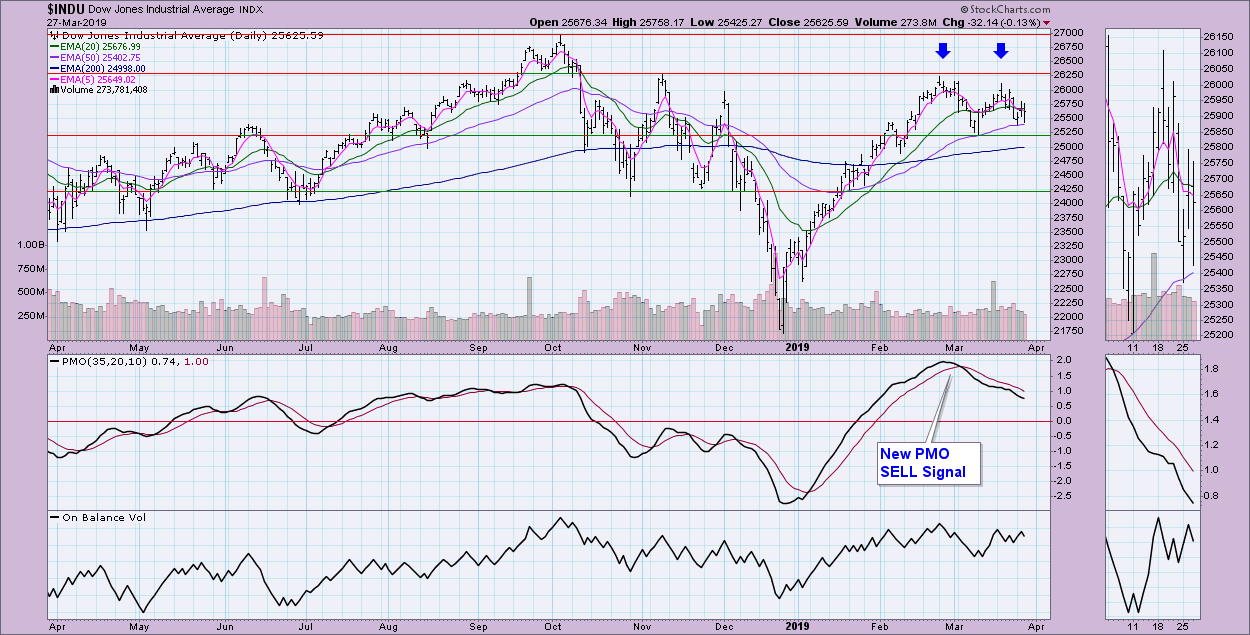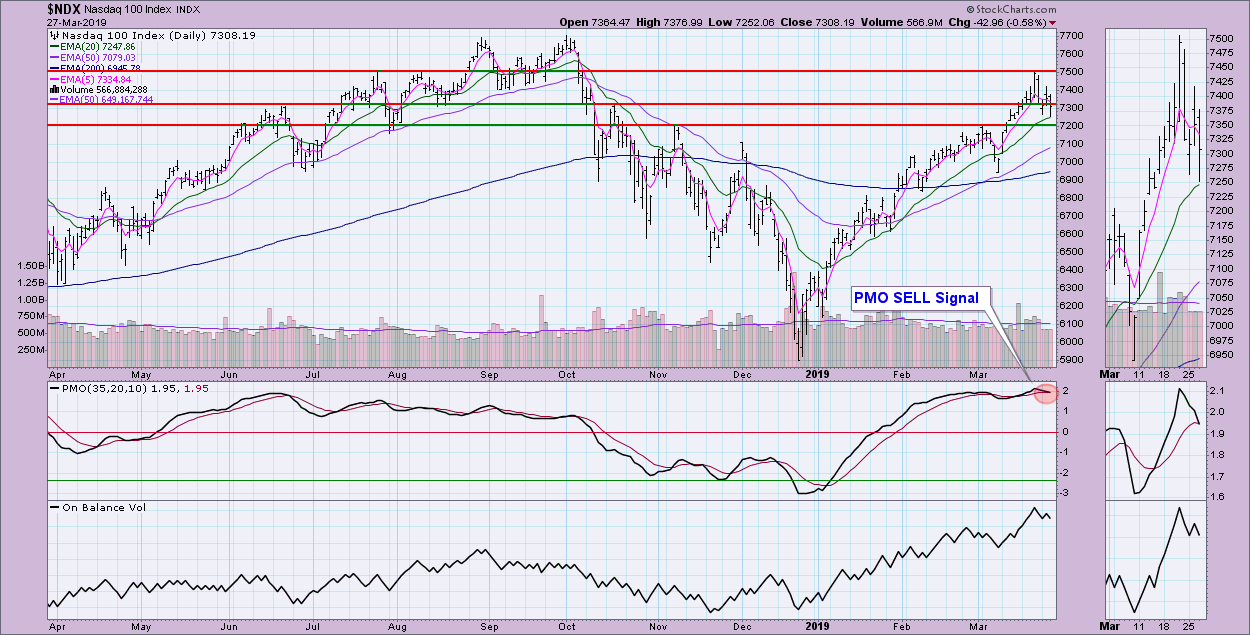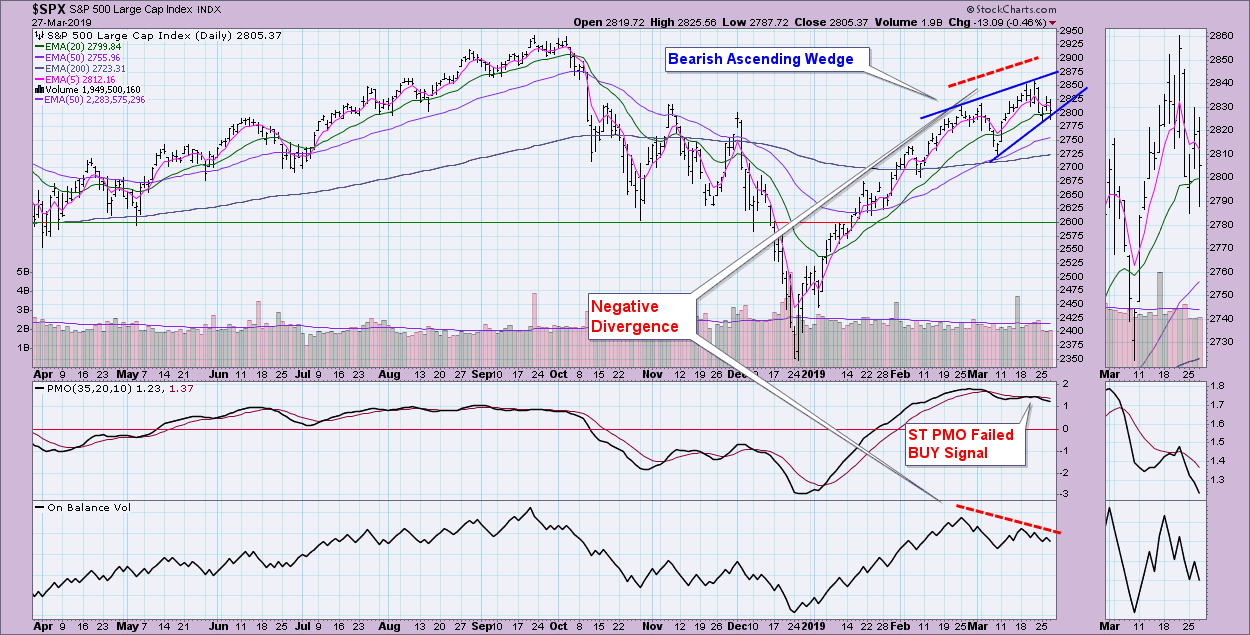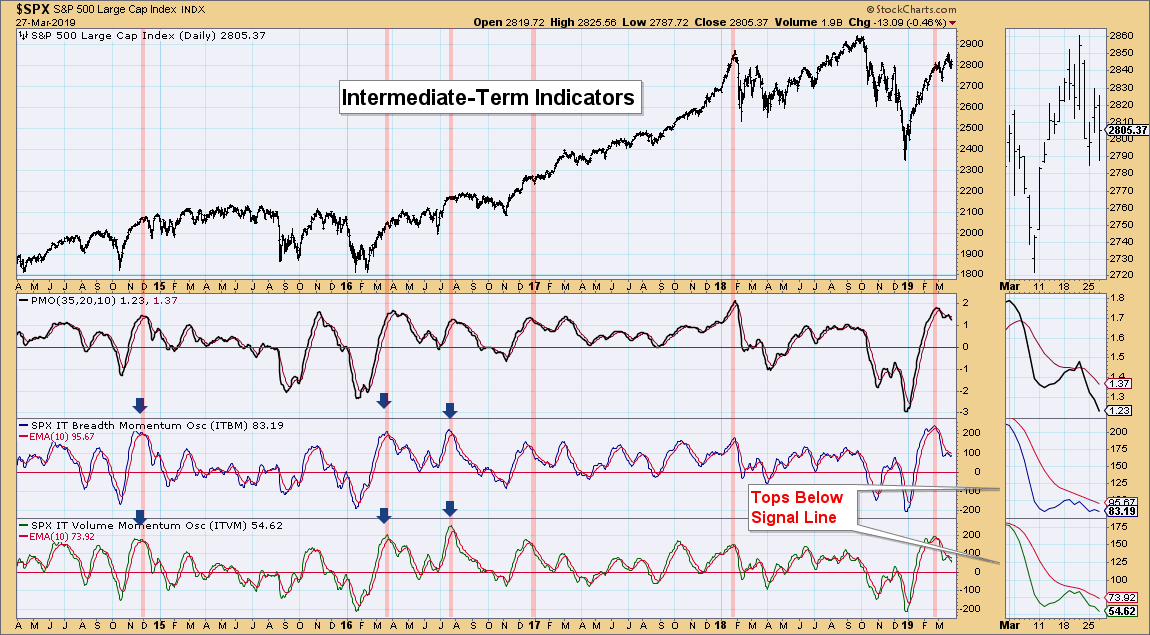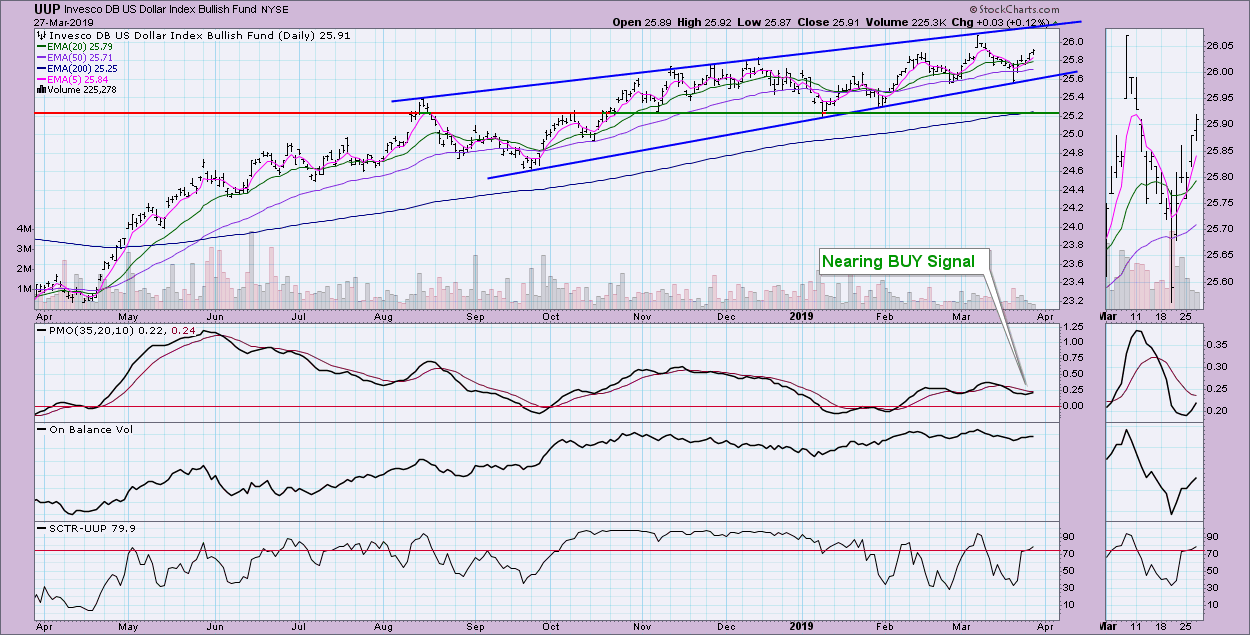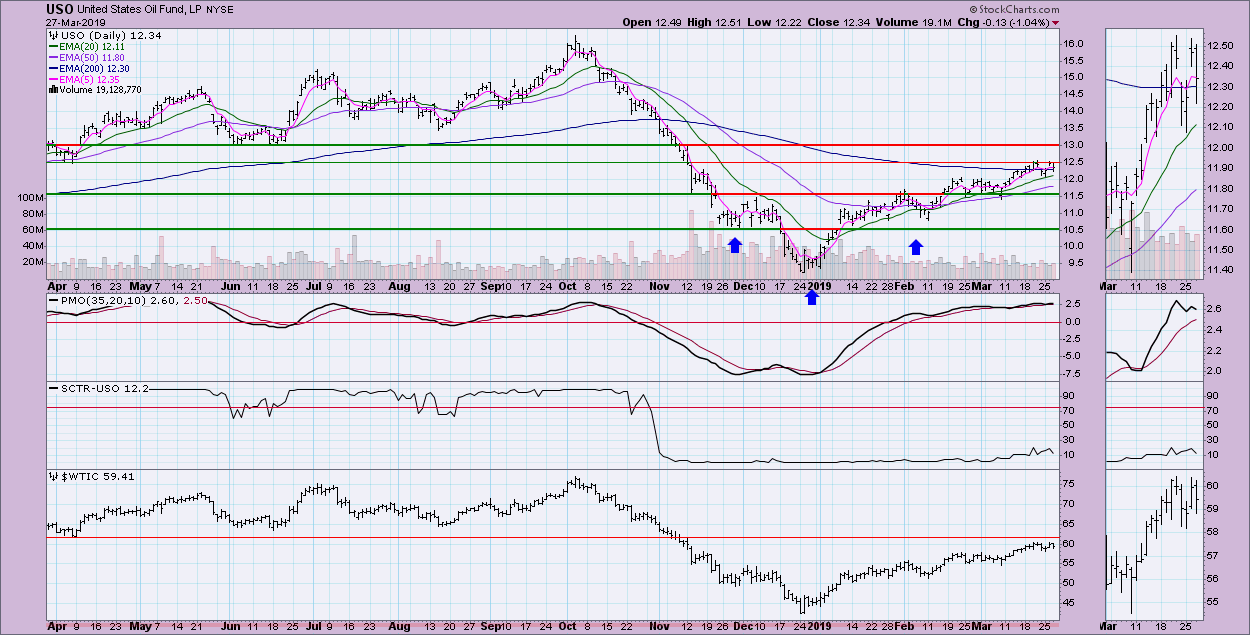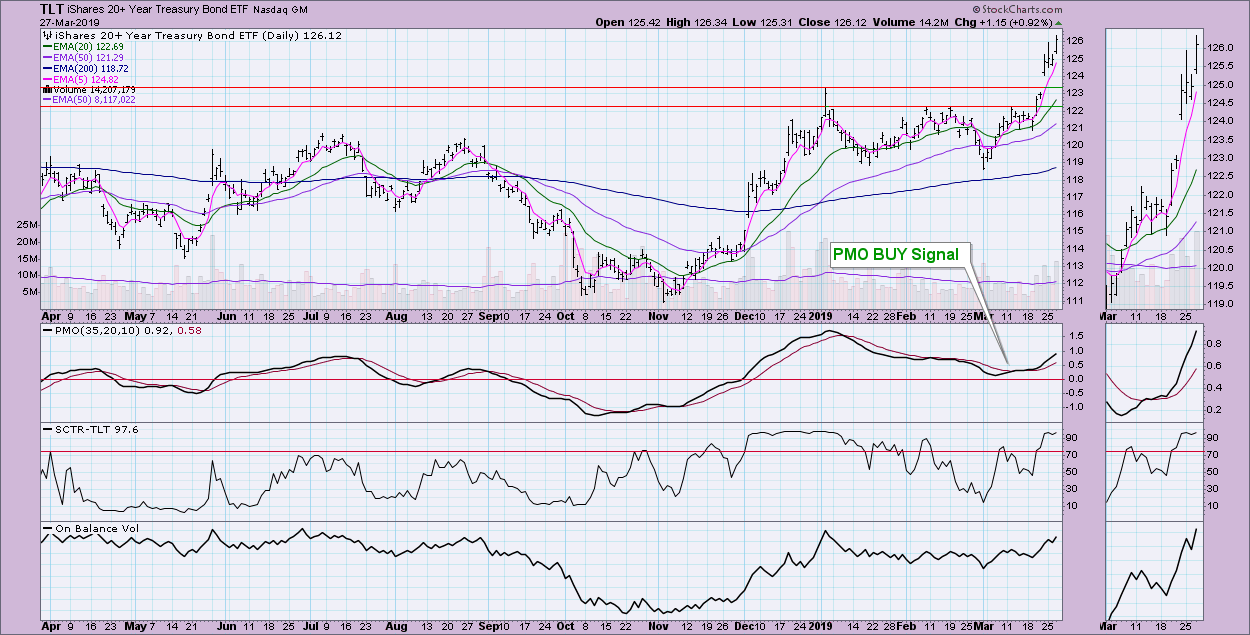
 The OEX and Dow lost short-term BUY signals on Monday and the NDX followed today, having switched out of a ST PMO BUY signal. I thought it was time to do a review of the Scoreboard indexes, so their charts are below. Additionally, you'll find my regular mid-week review of the SPX, indicators and "Big Four."
The OEX and Dow lost short-term BUY signals on Monday and the NDX followed today, having switched out of a ST PMO BUY signal. I thought it was time to do a review of the Scoreboard indexes, so their charts are below. Additionally, you'll find my regular mid-week review of the SPX, indicators and "Big Four."
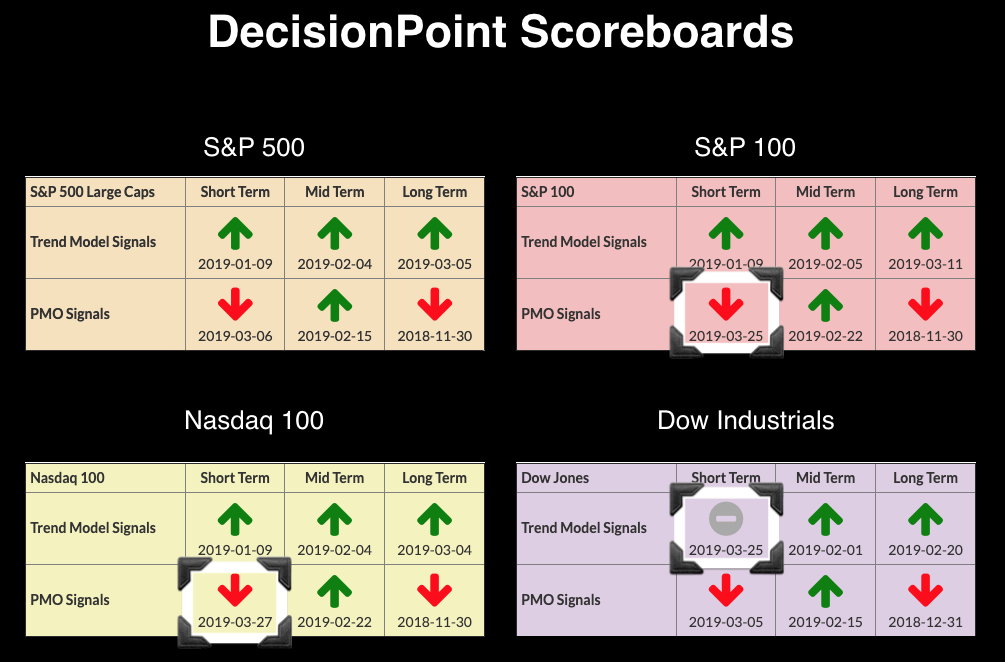
The Dow appears to have a double-top forming; it will become official should it execute with a drop below the confirmation line (about 25250). The minimum downside target for the pattern would be a move down to 24250. Currently, the 50-EMA is providing support, but the PMO is suggesting it will break below that level.
There's no double-top on the NDX. The 20-EMA is currently providing support, but today's new PMO SELL signal suggests that price will likely test and drop below support at 7200.
There's a bearish rising wedge on the OEX, which can be formed using either the 2018 low or the March low. Price has closed above the 20-EMA after testing the water below twice this week. I suspect that third time will be the charm and the wedge will execute.
The DecisionPoint Alert presents a mid-week assessment of the trend and condition of the stock market (S&P 500), the U.S. Dollar, Gold, Crude Oil and Bonds.
Watch the latest episode of DecisionPoint on StockCharts TV's YouTube channel here!
SECTORS
Each S&P 500 Index component stock is assigned to one, and only one, of eleven major sectors. This is a snapshot of the Intermediate-Term and Long-Term Trend Model signal status for those sectors.

STOCKS
IT Trend Model: BUY as of 2/1/2019
LT Trend Model: BUY (SPY) as of 2/26/2019
SPY Daily Chart: Just like the OEX, a wedge can be drawn from the 2018 low or, in this case, the March low. Price pierced the rising bottoms line, but the close was safely above both it and the 20-EMA. The PMO is looking very bearish with the recently failed BUY signal, as well as the quick descent since that failure. The negative divergence with the OBV suggests that it's only a matter of time before the breakdown.
Climactic Market Indicators: Nothing much on these. Note that the lower Bollinger Band puncture didn't amount to much upside; as both Carl and I suspected, it was a selling initiation, not a selling exhaustion.
Short-Term Market Indicators: These have turned up, which is bullish, though I note that the STO-V appears less enthusiastic. I like to see volume indicators react similarly to their breadth brethren.
Intermediate-Term Market Indicators: Declining IT indicators are bearish. We can now add to that another top below the signal line.
Conclusion: The bearish chart pattern, the declining PMO, the declining OBV and lackluster indicators suggest lower prices ahead in all timeframes.
DOLLAR (UUP)
IT Trend Model: BUY as of 2/7/2019
LT Trend Model: BUY as of 5/25/2018
UUP Daily Chart: At this point, I've decided to stick with a longer-term rising wedge in order to characterize what's going on with the Dollar. There's no denying its rising trend, but it should be noted that tops are not rising at the same pace as the wedge is forming. At this point, the PMO is moving back up with price as it attempts to test the top of the wedge. While I suspect that will occur, I will be surprised if price can break above the current ceiling.
GOLD
IT Trend Model: BUY as of 10/19/2018
LT Trend Model: BUY as of 1/8/2019
GOLD Daily Chart: Gold has been in a steady rising trend channel. The PMO is looking anemic, but I'm noticing that the reverse correlation between Gold and the Dollar is fading. I continue to be bullish on Gold and, given the decoupling going on again, a rising Dollar might not be a problem for the rising trend.
CRUDE OIL (USO)
IT Trend Model: BUY as of 2/19/2019
LT Trend Model: SELL as of 11/23/2018
USO Daily Chart: Nice and steady rising trend for Oil. Overhead resistance is very close for $WTIC; if you go from the April low for USO at $12.50, it could explain why we're seeing price struggle at this level. The PMO is struggling, but hasn't completely given up. Might be time for some sideways consolidation and an opportunity for the PMO to unwind.
BONDS (TLT)
IT Trend Model: BUY as of 12/6/2018
LT Trend Model: BUY as of 1/2/2019
TLT Daily Chart: TLT has exploded to the upside. The PMO gave us a BUY signal just before the giant gap up. I see no negatives on this chart right now; I suspect TLT will be rising higher still.
Technical Analysis is a windsock, not a crystal ball.
Happy Charting!
- Erin
**Don't miss any of the DecisionPoint commentaries! Go to the "Notify Me" box toward the end of this blog page to be notified as soon as they are published.**
NOTE: The signal status reported herein is based upon mechanical trading model signals, specifically, the DecisionPoint Trend Model. They define the implied bias of the price index based upon moving average relationships, but they do not necessarily call for a specific action. They are information flags that should prompt chart review. Further, they do not call for continuous buying or selling during the life of the signal. For example, a BUY signal will probably (but not necessarily) return the best results if action is taken soon after the signal is generated. Additional opportunities for buying may be found as price zigzags higher, but the trader must look for optimum entry points. Conversely, exit points to preserve gains (or minimize losses) may be evident before the model mechanically closes the signal.
Helpful DecisionPoint Links:
DecisionPoint Shared ChartList and DecisionPoint Chart Gallery
Price Momentum Oscillator (PMO)
Swenlin Trading Oscillators (STO-B and STO-V)

